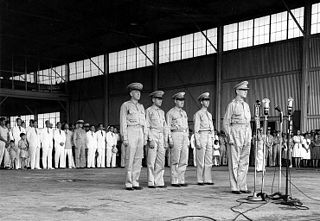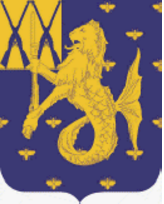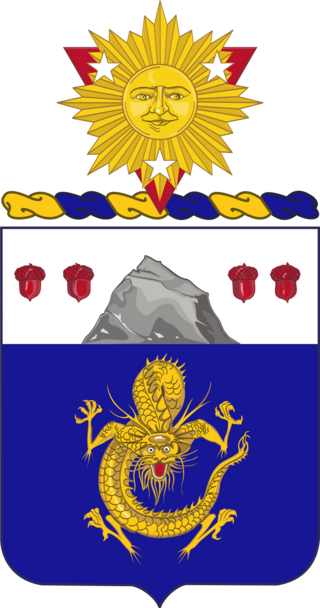
United States Army Forces in the Far East (USAFFE) was a military formation of the United States Army active from 1941 to 1946. The new command's headquarters was created on 26 July 1941, at No. 1, Calle Victoria, Manila, Luzon, the Philippines, with General Douglas MacArthur as commander. The Chief of Staff was Brigadier General Richard K. Sutherland and the Deputy Chief of Staff was Lieutenant Colonel Richard J. Marshall. The core of this command was drawn from the Office of the Military Advisor to the Commonwealth Government of the Philippines.

The 43rd Philippine Scout Infantry Regiment was part of USAFFE's Philippine Division, during World War II.

The 15th United States Infantry Regiment is a parent regiment in the United States Army. It has a lineage tracing back to the American Civil War, having participated in many battles.

The Philippines campaign, also known as the Battle of the Philippines or the Fall of the Philippines, was the invasion of the American territory of the Philippines by the Empire of Japan and the defense of the islands by United States and the Philippine Armies during World War II.
The 61st Regiment of Foot was an infantry regiment of the British Army, raised in 1756. Under the Childers Reforms it amalgamated with the 28th Regiment of Foot to form the Gloucestershire Regiment in 1881.

The 61st Division of the Philippine Army was an infantry division from the 1941 to 1942.

The 71st Infantry Division was a reserve division of the Philippine Army that fought under the United States Army Forces in the Far East (USAFFE). It was known for its fight with Japanese invading forces in Layac Junction, that was ordered to hold until all retreating Fil-American forces of crossed into Bataan Peninsula.

The 81st Infantry Division was a reserve division of the Philippine Army under the United States Army Forces in the Far East (USAFFE). It was established in the prewar period and fought 1941–1942. Its troops are from Cebu, Bohol, and Leyte but most of its troops are Americans and junior officers are Filipinos coming mostly from Luzon. The division served in defense of Mindanao but it never commanded the 4 of its maneuver regiments but was supplemented with 61st Infantry from Panay and 73rd Infantry from Negros. Also, 2nd Regular Regiment was transferred to its command in the early part of Japanese invasion of Mindanao.

The 101st Infantry Division was one the reserve divisions of the Philippine Army under the United States Army Forces in the Far East (USAFFE)'s 10th Military district mainly entire island of Mindanao.
The 102nd Infantry Division was a division of the Philippine Army under the United States Army Forces in the Far East (USAFFE).
Visayas-Mindanao Force was a military formation created in November 1941 to command all soldiers of US Army, US Philippine Scouts, Philippine Army, and Philippine Constabulary in the southern islands of the Philippines. Colonel William F. Sharp was appointed as commanding general and was promoted to Brigadier General in November 1941 and later Major General. His executive officer is Major Howard Edmands. He was just starting to organize his command and train his soldiers into a fighting unit when the war started on December 7, 1941.

Mindanao Force is a corps size military unit defending the island of Mindanao the second largest Island of the Philippines from March 17, 1942, to its surrender on May 9, 1942. The force was already created when the Visayas-Mindanao Force was split into two in March 1942. It was initiated in February 1942 in the headquarters of US Army Forces in the Far East but took effect when General Douglas MacArthur departed for Australia on March 17, 1942.
61st Infantry Regiment is a military unit and formation of the Philippine Commonwealth Army, activated in August 1941 in Panay Island. It is under the command of 61st Infantry Division of the Philippine Commonwealth Army. The regiment collapsed in May 1942 with its commanding officer captured by the Japanese Army in Lanao.
The 73rd Infantry Regiment of the Philippine Commonwealth Army was activated on August 25, 1941, was inducted to United States Army Forces in the Far East on September 1, 1941, by Captain Eugene B. Hicker of US Army. It was the last regiment among the three authorized to organized so it was not included when the entire 71st Infantry Division was ordered transferred to the main island of Luzon in September 1941.
101st Infantry Regiment is military unit and formation activated by Philippine Army during the early days of World War II. It was composed of Filipinos who resided in Mindanao, few officers from Luzon, Moros, and American soldiers assigned to command and train the regiment. It is known for his action in Davao province during the early days of war. It is credited for holding Japanese forces from reaching Kabacan for December 1941 to April 1942. It held them beyond Digos sector for 4 Months, that it needed reinforcements in April to reach Kabacan.

81st Infantry Regiment is military unit and formation of the Philippine Commonwealth Army

Visayan Force is a US Forces in the Philippines subcommand which was created and took effect on March 17, 1942, after General Douglas MacArthur departed for Australia. It was disintegrated in month upon its creation due to the lost of contact of Visayan Force headquarters during the Japanese invasion of Cebu in April 16 to 19, 1942, it resorted to guerilla warfare. Eventually all forces in the Visayas was ordered to surrender on May 11, 1942.
102nd Infantry Regiment is a military unit of the Philippine Commonwealth Army during World War II. I was activated in September 1941 and inducted to USAFFE on the same month. It fought under 101st Infantry Division under Brigadier General Joseph Vachon in Mindanao in Cotabato Province. The regiment did not fought as a unit each of the three battalions fought on different fronts and sectors.
103rd Infantry Regiment is a unit activated by the Philippine Army during World War II. I was organized in Mindanao in November 1941 which was not yet ready to fight when the war broke out. It is the last infantry element of 101st Infantry Division under Brigadier General Joseph Vachon.
82nd Infantry Regiment is a unit activated by the Philippine Commonwealth Army for the defense of the Philippine during World War II. It fought in the southern part of Cebu during the Japanese landings in Cebu island on April 16, 1942. It surrendered on May 12, 1942, after it was ordered by Visayas-Mindanao Force commander General Sharp to surrender.










